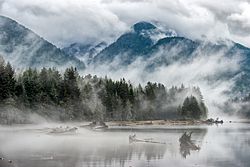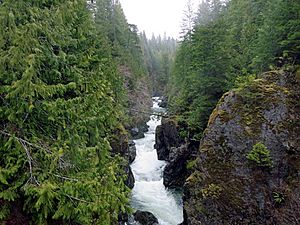San Juan River (Vancouver Island) facts for kids
Quick facts for kids San Juan River |
|
|---|---|

View up the San Juan River from Pacheena Reserve 1
|
|
| Country | Canada |
| Province | British Columbia |
| Region | Vancouver Island |
| Physical characteristics | |
| Main source | Seymour Range 735 m (2,411 ft) 48°43′39.5″N 123°59′33″W / 48.727639°N 123.99250°W |
| River mouth | Port San Juan Port Renfrew, British Columbia 0 m (0 ft) 48°33′33″N 124°24′31″W / 48.55917°N 124.40861°W |
| Basin features | |
| Tributaries |
|
The San Juan River is a cool river that flows across the southern part of Vancouver Island in British Columbia, Canada. It starts high up in the Seymour Range mountains. From there, it flows west through the San Juan Valley. Finally, it reaches the ocean at Port San Juan near a town called Port Renfrew.
Contents
River History: Amazing Stories
The San Juan River has some exciting stories from the past. These tales include old Spanish explorers and a lost gold mine!
Spanish Explorers and Gold
Long ago, in 1777, a legend says a Spanish trading ship came to Vancouver Island. The ship anchored in the harbour and traded with the local Nitinat First Nations people. The Spanish explorers supposedly found gold in the San Juan River. They tried to collect the gold, but the Nitinat Natives stopped them.
Two Spanish women were taken in by the Nitinat people. Later, another Spanish group found them and helped them go free. Sadly, this second Spanish group might have accidentally brought smallpox. This illness then spread to the Nitinat Natives. Some old records and ship logs seem to support parts of this story.
Foster's Lost Gold Mine
In 1885, an American gold seeker named Foster found gold in the San Juan River. He came back in 1907 to find more. Foster kept returning year after year, but he could never find the exact spot again. He died in 1917, still searching for his lost gold.
People in Port Renfrew heard about Foster's search. Many of them also looked for his old gold site along the San Juan River. But just like Foster, they never found it. The mystery of Foster's lost mine continues to this day!
River's Journey: Where it Flows
The San Juan River starts in the southern part of the Seymour Range mountains. Its waters come from the melting snow and rain there. The biggest part of the river begins at a small pond in the Cowichan Valley Regional District.
From this pond, the river flows southwest into another small pond called "Pete's Pond." Then it keeps flowing south. It enters the Capital Regional District and pauses in a large, unnamed pond. The river then continues south until it meets its first named stream, Clapp Creek.
After that, the river turns west-southwest and gets much wider. It keeps flowing down the valley, meeting another important stream called Fleet River. The San Juan River then winds through a narrow canyon. After the canyon, it opens into a wide valley. Here, it meets more streams like Lens Creek and Harris Creek. It also connects to a stream flowing out of Fairy Lake.
Finally, the San Juan River twists and turns a lot. It splits into two main branches, forming a large estuary where it meets the ocean. The smaller northern branch flows west and shares an outlet to Port San Juan with the Gordon River. The larger southern branch flows southwest and empties into Port San Juan just north of Port Renfrew.
San Juan River Estuary: A Special Place
The San Juan River Estuary Ecological Reserve is a protected area. It was created in 1996 to save the special forest near the river's mouth. This area is home to unique plants and animals. It also protects a rare flower called the tooth-leaved monkeyflower. This flower only grows in British Columbia. The reserve is a very strict nature reserve, meaning it's highly protected.
Plants and Trees in the Estuary
The estuary is full of different kinds of trees. You can find red alder, black cottonwood, Sitka spruce, and western hemlock. There are also many shrubs, like salmonberry bushes and stink currant. Smaller plants like piggyback plants, lady fern, and deer fern grow here too.
Animals Living in the Estuary
Many cool animals live in the San Juan River estuary. Keep an eye out for American black bears and Roosevelt elk. You might also spot North American river otters playing in the water. High above, bald eagles soar, and quick minks hunt along the riverbanks.


